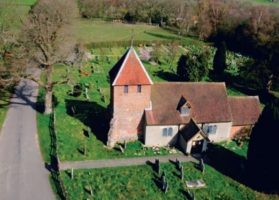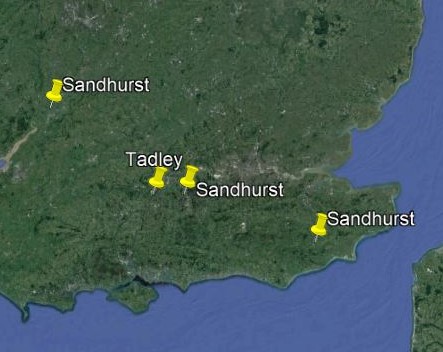The Great Sandhurst to Sandhurst Walk, via Sandhurst
by Graham Harding (assisted by Helen)
Graham and Helen moved to Sandhurst, Berkshire in 2004. Through misdirected post they rapidly found out there are two other Sandhursts in southern England and so was born the project to walk from the one in Gloucestershire to the one in Kent via their own. All of one hundred and eighty miles in more or less a straight line. Well it is until you take into account the obstacles to walkers which get in the way and attempt to stick to marked footpaths. After all there is not much pleasure in walking along the gutter of a trunk road or any road other than the most rural. The walk was split in two with Berkshire to Kent done in 2017 and Gloucestershire to Berks done in 2018, but Graham recounted it as if they did it from Gloucestershire to Kent.
Sandhurst, Glos. has a tiny population of only 450 compared to the 20,000 in Berkshire, while that in Kent has a population of 1,500. Obstacles to walking in a straight line include motorways and rivers, which mean finding bridges, Gloster airport was another, but the first they encountered was flooding of the area just after they started (April), so it is not as easy as it appears. Graham talked about places of interest on their route. The Air Balloon pub on Birdlip hill, overlooking the Severn valley; the Chedworth village sign incorporating local things of interest; the A49 Fosse Way Roman road; Colm Rogers a Thankful Village (none of their soldiers killed in WW1); Bibury, a picturesque village overstuffed with tourists; St Mary’s Church at Fairford, a great wool church with 28 medieval stained glass windows (well worth seeing – Ed); Lechlade has a Christmas shop which seemed rather incongruous in June; 5 miles of the Thames path; Iron age forts, including Uffington on a very hot day and being thankful for a memorial water tap high on the downs.
Then getting nearer to home when crossing into Berkshire at Lambourn and following the river Lambourn all the way to Newbury and the Watermill theatre. A section of the Kennet and Avon Canal towpath and pass through our own patch to see Calleva Atrebatum and Silchester Church, before going east along the Devil’s Highway to the River Blackwater and Eversley Ford on the Hants/Berks border. Since it was by now November it is fortunate there is a footbridge across the river. Finally the very awkward railway bridge in Sandhurst and home, very near to the Royal Military Academy.
The second part started in an icy cold January by following the River Blackwater into Surrey and towards the Hog’s Back (the North Down running from Farnham to Guildford) and finding the tiny village of Christmas Pie – possibly a farmstead (Pie) belonging to the Christmas family, and the nearby ancient Church of Wanborough. No time to look in the Watts Gallery at Puttenham, nr. Guildford (G F Watts Victorian Painter and Sculptor) now a World Heritage site. Then find the River Wey and the Wey and Arun Canal which is being restored. Through Bramley and Wonersh seeing the old railway station and then the cap windmill at Ewhurst. Leith Hill a high point of Southern England, where the mud was extremely sticky and on into West Sussex not far from Gatwick Airport and negotiate the major obstacle of the A23 which runs north to south. The Bluebell Railway had a bonus in the visiting form of the Flying Scotsman. The Ashdown Forest village of Hartfield is the centre of Winnie the Pooh territory, and passing a deer park they not only saw deer but an adder. And so from Sussex into Kent.
The early paths in Kent were memorable for an encounter with the worst stile of the whole walk. Stiles are important to walkers. Another Roman Road was crossed – this one runs from Rochester to Hastings. Then they see the splendid Bodiham Castle before finally making it to the third Sandhurst.
You may have noticed from the references to months that these walks took a very long time, around 5 to 6 months. I originally envisaged them walking from one good hotel or B&B to another with a good bath and meal at the end of each day, but no they do it in a more measured way which fits around work and life by using his and hers cars and both driving to the finish of the day’s planned walk. They then both go in one car to the start and walk. Thus they have a car at both ends of the walk. In this way they do segments of 5 to 6 miles at a time. They do have a hotel break at the start and finish, and why not?
However you do it, it is a very good way of experiencing the English countryside in all its seasons. Well done Graham and Helen and thank you for telling us about your 180 mile walk across southern England.
Richard Brown
(TADS Newsletter June 2021)


